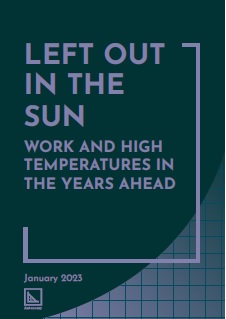Key findings
- Unlike other countries, the UK currently has no statutory maximum working temperature. Along with a built environment poorly suited to increasing heat, the UK is unprepared for the hot summers that will become ‘the new normal’.
- We show the millions of UK workers set to be exposed to excessive, dangerous working temperatures over the coming decades, as well the occupations and regions likely to be most heavily affected.
- Drawing on the Met Office’s UKCP18 Probabilistic Projections, we look at two different effects of global warming on the UK climate – increased extreme heat events (i.e. ‘hotter’ heatwaves) and higher average (‘day to day’) summer temperatures – modelling a range of different climate pathways and sensitivities.
- We categorise occupations into those which are ‘exposed’, through being particularly sensitive to extreme temperatures (e.g. outdoor work and work with heavy machinery) and those which are ‘vulnerable’, where work is affected by higher temperatures, but is less exposed (e.g. office-based work).
- We find that approximately two-thirds of the UK labour force could find themselves working in extreme heatwaves above 35°C – similar to those of July and August 2022 – by the end of the 2020s. Under the IPCC’s ‘business-as-usual’ climate pathway and conditions of high sensitivity, by 2050 these extreme heatwaves could leave almost 28 million workers unprotected from dangerous temperatures: 6 million in the most highly exposed category, with a further 22 million ‘vulnerable’.
- Higher average, ‘day-to-day’ temperatures are also set to take a significant toll. Under the IPCC’s ‘business-as-usual’ pathway and high sensitivity, by the 2040s more than 1 million of the most exposed workers would have to work in temperatures above 27°C throughout the summer, setting a dangerous ‘new normal’.
- Outdoor workers are set to be one of the first groups to be affected, with workers in construction and cleaning activities some of the hardest hit.
- The most ‘exposed’ workers will be clustered in specific regions: we find that Birmingham, Hertfordshire, Barnsley, Doncaster, Rotherham, Lincolnshire and Staffordshire are likely to be most affected. Business-as-usual scenarios are particularly alarming for Hertfordshire, where a warmer summer would take its toll by late-2040s.
- We outline policy recommendations necessary for the UK and its workers to weather hotter summer temperatures, following the TUC’s guidance of a new statutory maximum working temperature of 27°C for strenuous work and 30°C for indoor work, along with greater regulation of outdoor work. With many UK workers already frequently exposed to such conditions, change is required immediately.
- The UK should also expand retrofitting programmes to encompass workplaces as well as housing stock, while ensuring that planning does not rely on overly optimistic modelling conditions.




